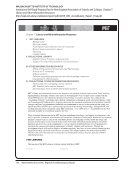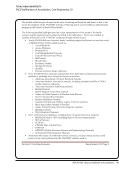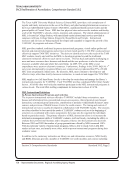SPEC Kit 330: Library Contribution to Accreditation · 15
It may be that the survey was conducted during
an extended time of transition for accrediting agencies
and higher education institutions. Accrediting bodies
are shifting quantitative measures of library effective-
ness (volume counts, hours open) to outcomes-based,
qualitative measures. Libraries now must explain how
their operations enhance student learning and institu-
tional effectiveness, and, as a result, have a great deal
of flexibility in how justification is provided. Libraries
must determine what is appropriate and adequate,
and make the case they meet the standards set by
accrediting bodies.
For the time being, ARL member libraries can
neither stop counting nor avoid justifying their ef-
fectiveness in supporting the mission of the larger
institution. While a one-size-fits-all approach to pro-
gram reviews and accreditation is neither feasible
nor desirable, there is merit in a holistic approach to
collecting and reporting library assessment data for
accreditation. In 2005, ARL library directors indicated
that the current ARL statistics failed to adequately de-
scribe or measure the effectiveness and impact of a 21st
century research library. Since then, ARL has begun
to lead the way in identifying more flexible statistics,
including both quantitative and qualitative metrics,
which can be collected and used as comparisons and
benchmarks to each of its member institutions.
1 Council for Higher Education Accreditation.
“CHEA-at-a-Glance” (2006), http://www.chea.
org/pdf/chea_glance_2006.pdf Accessed August
18, 2012.
2 Berry, Leonard L. On Great Service: a Framework for
Action. New York: Free Press, 1995.
It may be that the survey was conducted during
an extended time of transition for accrediting agencies
and higher education institutions. Accrediting bodies
are shifting quantitative measures of library effective-
ness (volume counts, hours open) to outcomes-based,
qualitative measures. Libraries now must explain how
their operations enhance student learning and institu-
tional effectiveness, and, as a result, have a great deal
of flexibility in how justification is provided. Libraries
must determine what is appropriate and adequate,
and make the case they meet the standards set by
accrediting bodies.
For the time being, ARL member libraries can
neither stop counting nor avoid justifying their ef-
fectiveness in supporting the mission of the larger
institution. While a one-size-fits-all approach to pro-
gram reviews and accreditation is neither feasible
nor desirable, there is merit in a holistic approach to
collecting and reporting library assessment data for
accreditation. In 2005, ARL library directors indicated
that the current ARL statistics failed to adequately de-
scribe or measure the effectiveness and impact of a 21st
century research library. Since then, ARL has begun
to lead the way in identifying more flexible statistics,
including both quantitative and qualitative metrics,
which can be collected and used as comparisons and
benchmarks to each of its member institutions.
1 Council for Higher Education Accreditation.
“CHEA-at-a-Glance” (2006), http://www.chea.
org/pdf/chea_glance_2006.pdf Accessed August
18, 2012.
2 Berry, Leonard L. On Great Service: a Framework for
Action. New York: Free Press, 1995.
























































































































































































